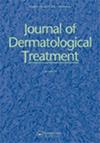Postoperative risk assessment of post-inflammatory hyperpigmentation and the efficacy of delayed prevention following 532 nm Q-switched Nd:YAG laser treatment of solar lentigines: a randomized controlled study.
IF 3.9
4区 医学
Q2 DERMATOLOGY
引用次数: 0
Abstract
BACKGROUND Although post-inflammatory hyperpigmentation (PIH) is a common adverse event following laser procedures, studies evaluating its risk remain limited. OBJECTIVE To analyze PIH risk after 532 nm Q-switched Nd:YAG laser (QSNYL) treatment for solar lentigines and examine the efficacy of triple combination cream (TCC) for its prevention. METHODS In this single center, investigator-blinded, randomized controlled study, participants with solar lentigo either received TCC or emollient from 2 weeks post-QSNYL treatment. The occurrence of PIH was determined by three independent and blinded dermatologists. In vivo skin measurements and sun exposure questionnaires were examined to evaluate the risk of PIH. RESULTS A total of 28 patients with 67 solar lentigines were included in the analysis. In the control group, PIH occurred in 55.3% of the lesions. Risk factors for the occurrence of PIH were the increased erythema at weeks 2 (OR, 1.32; p = 0.035) and outdoor activity during 1-5 pm (OR, 8.10; p = 0.038). Treatment with TCC from 2 weeks post-QSNYL treatment significantly decreased the incidence of PIH (31.0% vs. 55.3%, p = 0.048). CONCLUSION Post-laser erythema and outdoor activity at the daytime are prognostic factors for the occurrence of PIH. Administering TCC could be considered for the prevention of PIH in high-risk patients.532 nm Q 开关 Nd:YAG 激光治疗日光性色素沉着后的术后炎症性色素沉着风险评估和延迟预防的疗效:一项随机对照研究。
背景虽然炎症后色素沉着(PIH)是激光治疗后常见的不良反应,但评估其风险的研究仍然有限。目的分析 532 nm Q-switched Nd:YAG 激光(QSNYL)治疗日光性色斑后出现 PIH 的风险,并研究三重组合霜(TCC)对预防 PIH 的功效。方法 在这项单中心、研究者盲法、随机对照研究中,患有日光性白斑的参与者在接受 QSNYL 治疗后 2 周开始接受 TCC 或润肤霜治疗。PIH的发生率由三位独立的盲人皮肤科医生确定。结果共有 28 名患者的 67 个日光性白斑被纳入分析。在对照组中,55.3%的病变发生了 PIH。发生 PIH 的风险因素是第 2 周时红斑的增加(OR,1.32;p = 0.035)和下午 1-5 点的户外活动(OR,8.10;p = 0.038)。结论 激光术后红斑和白天的户外活动是 PIH 发生的预后因素。高危患者可考虑使用 TCC 预防 PIH。
本文章由计算机程序翻译,如有差异,请以英文原文为准。
求助全文
约1分钟内获得全文
求助全文
来源期刊
CiteScore
6.50
自引率
0.00%
发文量
145
审稿时长
6-12 weeks
期刊介绍:
The Journal of Dermatological Treatment covers all aspects of the treatment of skin disease, including the use of topical and systematically administered drugs and other forms of therapy. The Journal of Dermatological Treatment is positioned to give dermatologists cutting edge information on new treatments in all areas of dermatology. It also publishes valuable clinical reviews and theoretical papers on dermatological treatments.

 求助内容:
求助内容: 应助结果提醒方式:
应助结果提醒方式:


